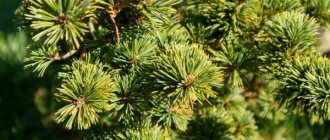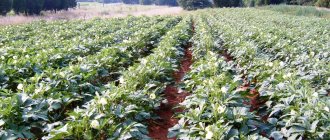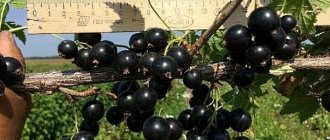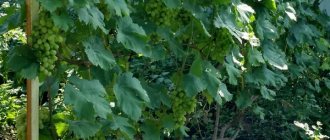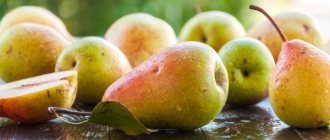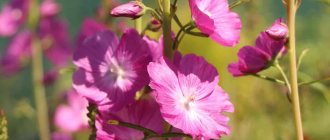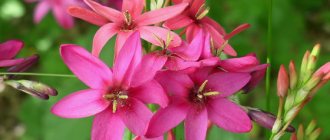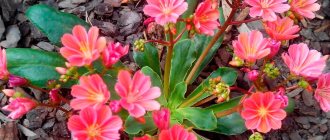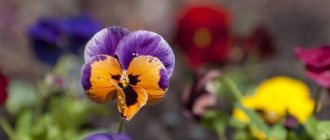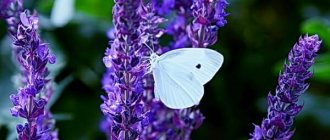Volzhanka or aruncus is a voluminous and very spectacular herbaceous shrub for the shady area of a personal plot. In its blooming form, this plant with a cacophonous translation (Greek - goat's beard) can give an absolutely incomparable feeling of warm summer, a bright holiday, lightness and freedom from city worries. It is enough to look at the photo of Volzhanka to imagine the volume, splendor and decorativeness of this frost-resistant and shade-tolerant perennial. Planting a flower in open ground, as well as its subsequent care, are simple and can be done by a gardener with any experience.
general description
Volzhanka is a large herbaceous perennial from the Rosaceae family. The plant has a great external resemblance to astilbe. In just one season, Volzhanka is capable of growing a large volume of green mass, due to which it is perceived not as a herbaceous plant, but as a monumental deciduous shrub. The culture is widespread throughout the temperate zone of the Northern Hemisphere, so it easily overwinters in Russian gardens and household plots.
Arunkus has a highly branched root system of the surface type. Over the years, its woody roots are worn far beyond the planting area. Erect, strong skeletal branches remain overwintering, dropping their foliage. Growth is uneven; in the first years it is insignificant, but later the plant can reach one and a half meters. Its spreading crown is slightly smaller in width.
The long-petioled foliage has a bright green color and carved edges. Peduncles are a continuation of the stems and can reach more than half a meter in length. The flowers, pure white or light cream in color, are small in size (up to 3 mm), collected in dense spike-shaped inflorescences. Due to the protruding green perianths, they have a slight greenish tint. On one specimen, their bisexual varieties develop. Men's ones are distinguished by their special splendor and density, women's ones are determined by the openwork edge and are seated more sparsely.
Flowering occurs in the first half of summer. Blooming aruncus fills the garden with a tart and strong honey aroma that attracts large numbers of bees and other pollinating insects. Leaflet fruits ripen much later, in September, the seeds are very small and dusty.
The annual growth of roots in tall varieties is 5-7 cm per year.
Popular types and varieties of Volzhanka
Another name for Volzhanka is aruncus. This plant belongs to garden crops, lives for several years and is a real decoration of any site. This is a flower that does not require special care, but at the same time develops well and blooms profusely.
It is better to grow the Noble Spirit variety as a houseplant.
Volzhanka Horatio
This plant does not grow too tall - up to 65 cm. It is distinguished by its original horatio stems, which have a red tint. Therefore, the flower is widely used to decorate flower beds and winter gardens.
It is recommended to grow this variety in one place for no more than 5-7 years. If you take proper care, the flower will live for over 10 years and will delight you with its original flowering all this time. Proper care involves systematic watering, especially if the bush is constantly exposed to direct sunlight. It is also recommended to periodically feed the crop.
Kamchatka Volzhanka
Under natural conditions, this type of plant lives in Kamchatka, Alaska, Sakhalin, the Far East, Japan, Korea, and Okhotia. This flower is quite tall. With proper care it reaches more than one and a half meters. Oval leaves, lush inflorescences, a strong root system - these are the main features of Kamchatka aruncus. Flowering occurs in mid-summer, seeds ripen in September. The best place for the shrub is partial shade. Because of this, it is often used to decorate flower beds near which trees are planted.
Volzhanka etusifolius
This species is one of the smallest. The bush grows up to 27 cm tall. White or beige flowers are collected in long inflorescences. The leaves of the plant are oval and bright.
The most famous variety is Noble Spirit. The bush reaches a height of 35 cm. Flowering occurs in early summer. When open, the buds acquire a snow-white hue. After the flowers wither, the inflorescences remain and delight the eye with their decorative appearance for a long time. They turn brown and seeds appear inside. In order for Noble Spirit to please with abundant flowering, you should provide it with good drainage, as well as periodically fertilize and loosen the soil.
Varieties of Volzhanka with photos
In the wild nature of the temperate climate zone, there are just over a dozen species of Volzhanka. It grows in light forests, where it is quite content with rare flickering light, choosing the most shaded and damp places. The following varieties are of interest for cultivation.
Arunkus dioecious
Found in fairly damp deciduous forests. Often referred to as forest or common. Tall, can reach the height of a person. The stems are erect, weakly leafy, but under the weight of flowering panicles they are prone to lodging and become splayed and wide. Openwork long-petioled leaves of small size sit in pairs, like those of ferns. The paniculate loose inflorescence is highly branched, up to half a meter in length. The male and female flowers of this variety are located on different peduncles.
Among the most decorative varieties of Arunkus dioecious, one can distinguish “Kneifi”. It is relatively low, about 60 cm, with long drooping shoots and bright, finely dissected, showy foliage.
Arunkus asiatica
With the same tall growth as the Kneifie variety, this variety of Volzhanka is distinguished by coarse foliage of a darker color. The panicles of the spike-shaped inflorescences are complex, thin, but dense, no more than 35 cm in length, and have a snow-white color. Due to its high frost resistance, the Asian variety, despite its southern name, can be found in colder northern regions.
The best varietal variety is “Fountains”. It has a compact growth and is distinguished by large, lush, drooping panicles. This variety looks especially impressive on the banks of reservoirs, but requires shading.
Arunkus Kamchatka
This species fully lives up to its name, growing in Kamchatka, Sakhalin, as well as the Kuril and Aleutian Islands. Unlike forest varieties, it prefers meadows, mountain slopes and seashores. It is undemanding to soil fertility, can grow even on rocky embankments, and has thick, woody roots in adulthood. The flowering panicle is weakly branched and has a relatively short size.
The Alpine subspecies of this species is even more compact and rarely rises more than 30 cm.
Arunkus americana
It is widespread throughout the temperate zone of the globe, including the Far Eastern region and North America. It produces a highly branched root system with good annual growth, thanks to which it can be used to strengthen slopes and banks provided there is sufficient moisture. It rises in height by more than a meter and is prone to active growth in breadth.
Volzhanka coryshefolia
One of the shortest varieties, very popular among gardeners. The reason for choosing this species is, rather, the compactness and high density of the bush, not exceeding 25 cm, rather than its decorative effect, since it produces less lush, shortened clusters of inflorescences, and flowering lasts much less - only 2 weeks.
Arunkus parsley
The second name of the species is etusifolius. It has a compact spherical shape no more than 30 cm in all directions. It blooms with snow-white flowers resembling miniature finger-shaped stars. The inflorescences are long, especially against the background of the low growth of the variety. Flowering is early, in May, lasts about a month. After the seeds ripen, the panicles acquire a reddish tint, which also looks very decorative against the background of dissected, openwork, brightly colored foliage.
This species has a particularly spectacular hybrid “Perfection” with snow-white fluffy clusters during budding and bright red panicles after the seeds ripen.
Combination with other plants
Volzhanka, hosta and fern
Volzhanka, roses and conifers
Astilbe is considered the most successful partner. But there are other combinations that gardeners love. These are combinations with conifers, hostas, Japanese spirea, and low-growing varieties of juniper.
Volzhanka propagation by seeds
The plant is easily propagated by seed, but the process of independently collecting seed material is difficult. The seeds do not ripen very well; in addition, due to the characteristics of dioecious flowers, not all ovaries remain pollinated. The dusty size of the seeds, which ripen in tiny leaflets, also poses certain difficulties. For collection, prepare a paper bag into which the inflorescence is carefully cut, where it is stored entirely until completely dry. After this, the seeds are crushed.
Depending on the region, seeds are sown either in boxes in early spring or directly in open ground in the fall. In the first case, at the two-leaf stage, the seedlings dive. When sowing in winter, this can be done when the weather permits. After picking, the distance between neighboring shoots should not be less than 10 cm. Young seedlings can be planted in a permanent location next year, maintaining a significant distance, taking into account their growth in width. Volzhanka produces its first flowering when planted from seeds at the age of 3-4 years.
It is not recommended to replant the aruncus at an older age; the place of permanent growth must be decided in the first 2 years, since the overgrown and lignified rhizome will not allow this to be done successfully and painlessly.
Arunkus: growing from seeds
You can also find arunux seeds on sale. Planting material is sown in early spring in large containers. In the southern regions, gardeners sow lupus directly into the ground in the fall. When a pair of leaves appears on the seedlings, the seedlings are picked and planted at a distance of up to 10-15 cm from each other. During the year, the seedlings grow in a container, and next spring they are ready for planting in open ground. When planting seedlings in a permanent place, it is important to maintain a distance between plantings, since Volzhanka quickly grows in breadth. The first flowering occurs only in the 3-4th year of the plant’s life.
Rhizome division
In the case of vegetative propagation, you can get a flowering plant in a shorter time. It is recommended to divide in early spring after the snow has melted, before signs of sap flow appear in the ground part. To do this, it is not necessary to dig up the entire mother bush; it is enough to dig out part of the overgrown rhizome. You will have to cut it with an ax or a sharp knife, since the root becomes woody and very strong. Each division must have at least one regeneration bud and part of the thread-like roots, which must be carefully preserved, since they are the ones that will nourish the plants during the rooting period. It is advisable to sprinkle the cut area with ash, chalk or coal. The delenki are buried immediately so that they do not dry out. Already in the first year after planting, a new plant can bloom.
Characteristics and care features
Volzhanka corysheleaf
Volzhanka corysheleaf is a shade-tolerant plant. But if you plant it in a sunny area, it should be quite moist.
In addition, in the sun, the leaves fade and acquire a yellowish tint. The Volzhanka is a lover of damp places, so it is often placed near bodies of water, where it looks quite decorative.
But if the area is too damp, it is recommended to build a drainage system to solve the problem. The soil for growing is suitable for ordinary garden soil, but given that the plant can survive up to 30 years without replanting, it should be planted in well-fertilized soil.
During growth, the plant can be fed with nitrogen fertilizer, and during flowering with phosphorus-potassium fertilizer. Volzhanka is frost-resistant. It is not covered for the winter, but it is better to cut off the strong stems, leaving small stumps (3-5 cm).
Volzhanka care
All varieties of the crop are more than unpretentious in cultivation. They are undemanding to soil characteristics, although they grow better on more fertile soils. The main condition is sufficient natural soil moisture. The banks of reservoirs and the close occurrence of soil water are excellent conditions for its growth. If natural moisture is not enough, frequent and abundant watering is necessary.
In terms of light, it prefers shady places, but can also grow in open places, although in these conditions the leaves will dry out faster and the vegetative growth of the perennial will be slowed down.
Fertilizers support aruncus well, but you should not abuse them. It is enough to seasonally add rotted organic matter and/or nitrogen compounds in the spring and fertilize with a mineral complex during the budding period. If desired, you can feed the aruncus at the end of summer after flowering with a potassium-phosphorus complex, so it will better survive the winter.
Caring for Volzhanka in the fall includes pruning shoots to 5 cm from the root. To ensure that the plant overwinters safely, you can mulch it with peat or fallen leaves. But shelter is not necessary, since the plant is frost-resistant and easily overwinters in a temperate climate zone.
An important condition for preserving the decorative appearance of the plant and its lush flowering is the timely removal of faded buds, if there is no purpose of collecting seed material. The exception is varieties with decorative inflorescences during the period of seed ripening.
Arunkus: growing conditions
Lighting for aruncus
Volzhanka is an unpretentious crop; in order to preserve the decorative appearance of its openwork leaves and inflorescences, it is better to plant it in shaded corners of the garden. If you are in an open area at noon, the leaves of the plant may get sunburned. Over time, they turn yellow and lose their attractiveness.
Soil for aruncus
Arunkus are not picky about the soil, and grow equally well in both heavy and light soils, of any acidity. The main condition for growing a plant is the presence of a sufficient amount of organic matter in the soil. In nutritious soil, the plant actively grows green mass.
Volzhanka in the landscape
Thanks to the monumental size of most species and their high decorative value, the plant is completely self-sufficient and can be planted as a tapeworm on lawns, near the shores of artificial and natural reservoirs, in the local area, in shady corners of the garden, hiding their ugliness. Due to their compact size, dwarf species will perfectly decorate garden paths, borders, and barbecue areas. Volzhanka looks great in group plantings along with conifers and other deciduous shrubs. If you plant it in the background of a flower bed, then its bright greenery after flowering will perfectly set off the blooming summer flowers.
When cut, aruncus panicles do not live long, but are excellent for drying and making dry compositions. In this case, you should be prepared for the fact that the dried plant will cause significant litter upon contact with it.
Use in landscape design
Volzhanka, as a plant that does not require care, is often used in landscape design to create picturesque thickets. They perfectly disguise unsightly fences, structures, traces of communications, etc. If a gardener has planned to create backstage and ceremonial plantings, then you won’t find a better plant than Volzhanka. The soft, delicate shade of the bush will add a touch of romanticism to the landscape and smooth out strict architectural forms.
When planting a plant near the water, you can admire the incredibly beautiful reflection of the flowering shrub in the water. And the pleasant subtle aroma emanating from Volzhanka will turn the garden into a paradise. Due to its unpretentiousness, the garden planting can be planted at the very edge of the water or in the coastal zone. The culture combines well with other plants, which allows you to create an original mixborder near the elements of water.
Volzhanka is a very good honey plant. Thanks to this, it attracts numerous pollinators to the site. Taking advantage of this property, gardeners plant fruit trees nearby and enjoy a good harvest at the end of summer.
Varietal varieties
Ornamental shrubs differ only in height or shape of inflorescences. The leaves on each plant are the same, they are distinguished only by size. Miniature varieties have small leaves.
- The most common bushes are the common aruncus. It has the largest beautiful decorative leaves. And it can be up to 2 meters in height. It usually blooms from early June to mid-July. The plant comes in different genders: female flowers are snow-white, male flowers are creamy and their inflorescences are denser. This bush requires almost no care.
- Another popular variety among flower growers is the Kamchatka Volzhanka mini. It is slightly lower than the ordinary variety, about half a meter. And the inflorescences of this variety are smaller.
- But the most popular is the dwarf aruncus. These are varieties that can be classified as miniature, which is why they are often called dwarf. Compared to their two-meter brethren, they really look like dwarfs. For example, American or Asian Volzhanka. Their height is no more than a meter, and they do not bloom as profusely as their tall counterparts. These varieties bloom from May to the end of June, sometimes July.
- The smallest is the cory-leaved Volzhanka mini, which is about 30 cm tall, no more. There is also such a variety as Noble Spirit. Its round bush, as a rule, grows up to 25 cm in height, not higher. And snow-white inflorescences decorate the flower garden until mid-summer. And after flowering, their decorative properties are still preserved. Even the seeds on the branches look quite beautiful.
- Only the Knife variety requires the most careful care. This variety differs from the others in its special elegance of leaves and small height. But in terms of endurance, he loses next to his relatives. And it requires much more care.
Volzhanka, aka goat beard
It often happens that beautiful plants have completely strange, at first glance, names. This fate did not spare the Volzhanka either. With the Russian generic name - Volzhanka - everything is quite clear, but the Greek name - Aruncus (Aruncus) when translated sounds clearly strange and literally means “goat beard”. This is how the plant was christened back in the Middle Ages, although the name initially sounded somewhat different: Barba caprae, although it had the same meaning. Well, much later, the already familiar aruncus .
The question immediately arises: for what sins did botanists call this beautiful plant exactly that? But in botanical science nothing happens just like that. If you look closely at Volzhanka, its fluffy large inflorescences are somewhat similar to a beard.
Volzhanka is decorative due to its delicate feathery leaves and lush paniculate inflorescences
Volzhanka is an interesting representative of the Rosaceae family . The number of species in this genus is controversial, and few people know exactly how many there are. Previously, this genus included up to 12 species, but times are changing, and now their number has been reduced to 3-4.
Volzhanka grow in temperate regions of the Northern Hemisphere. These plants are decorative all season long due to their delicate feathery leaves and beautiful lush paniculate inflorescences, consisting of many small creamy-white flowers.
The best hybrids
Popular hybrid varieties that are increasingly found on the windows of high-rise apartments:
Johannisfest. This is a small bush, the height of which does not even reach 40 cm. It has fluffy spreading shoots. The leaves are bright and large. Blooms in pink and cream shades. The shape of the inflorescences resembles panicles with graceful curves. The variety tolerates drought and heat well. Therefore, even slightly dry soil will not harm the bush. Unpretentious Volzhanka for the garden - video
Volzhanka - an openwork miracle
Although, on the other hand, this is the beauty of owning your own summer cottage...
Volzhanka dioicus (dioecious, common): plant characteristics
This Volzhanka variety comes from the Caucasus. Despite the external resemblance to astilbe, the plant differs in the size and color of its buds. They are completely different, it all depends on the gender of the flower. In Volzhanka dioecious, female flowers are often painted only white, but male flowers acquire a beige tint. As for the size, the buds are quite large, in addition, they are much more powerful than those of astilbe.
Volzhanka lives for more than 9 years in one area. In autumn, its leaves become rich red and do not fall off for a long time.
The dioecious Volzhanka grows up to 1.9 m tall. The plant is distinguished by long, even stems. With proper care, the bush grows in diameter up to 1.1 m. Leaves appear from the thick petioles, which are somewhat similar in appearance to the plates of a fern.
There are the following types of common Volzhanka:
- Forest Volzhanka Ginea fauve. The plant produces white and pink flowers and reaches 1.9 m in height.
- Volzhanka Kneffi.
The flower loves water, grows no more than a meter, and is distinguished by carved branched leaves. Varieties of Volzhanka dioecious In the garden of flower growers, you can often see Volzhanka dioecious and its interesting varieties.
